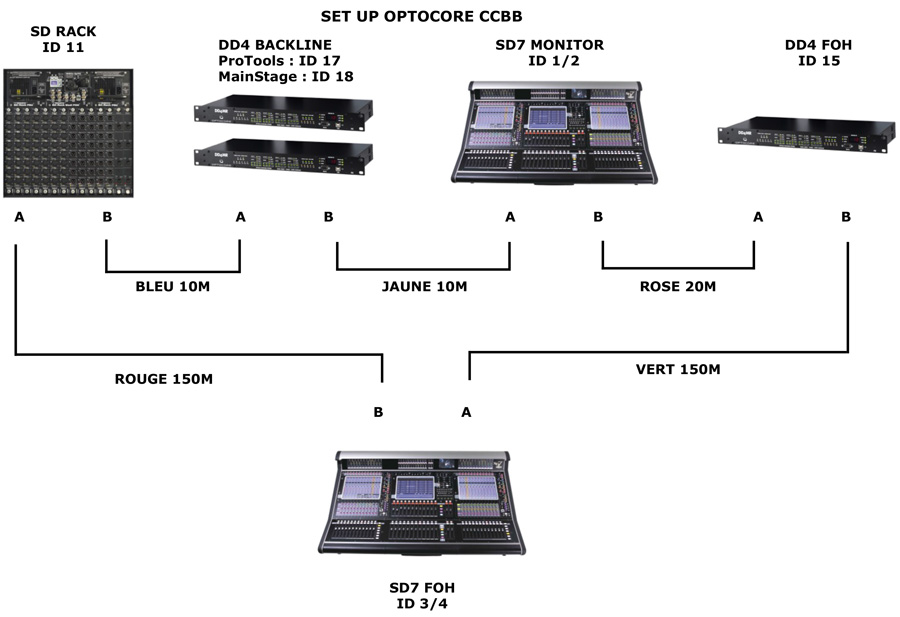1988. I attend the Grand Rex in Paris at the screening of The Big Blue, and like the whole audience in the room, I come out conquered, possessed by the movie story but above all its music, in such close connection with the images on the screen. 30 years later, the major work of the Luc Besson & Eric Serra team is screened again in a film concert format. Nothing has changed, but everything is better.
Autumn 2017, Maxime Menelec, young and talented French sound designer, system engineer and team leader spreads the word that an event in full L-Isa is being prepared and advises us to put our Friday May 11, 2018 date in our agenda. No way to know more, we drop the song, relieved by the: “… I will call you when we are in the studio, you will understand” cleverly slipped.
The weeks go by and at the end of January, an appointment is made in a small dead end street not far from Montmartre. The doorbell rings aside an armored door. Once crossed, the decor, the smell of warm electronics and – even more – the chords that resonate leave no room for doubt. It smacks of Eric Serra indeed.

Two key figures in the “The Big Blue celebrates its 30th anniversary” adventure come to meet us. Maxime who gives up his L-Isa configuration for a few minutes based on X8 L-Acoustics and Romain Berguin, a strategic character who, with Jean-Philippe Schevingt which we will talk about later, form the trio that Eric Serra will warmly thank a few months later on the Seine Musicale stage (in Boulogne near Paris) at the end of the screening. This was rightly done indeed. But we’ll see this later.
The work we are witnessing briefly this winter afternoon leaves us speechless. Yes, all the musical elements exist, even the session of Performer of the ol’ time, because Eric Serra has meticulously kept everything including the MidiVerb, sorry, the “Midiiiiiihhhhhhherb”, and took care a few years earlier to transfer to ProTools, the then staple multitrack.
Indeed Eric knows exactly the keyboards, effects and other tricks he used to generate these endless reverberations which got the better of sonically transparent cinema screens and big drivers with sadly academic curves in movie halls, but now everything has to be dug out, cleaned or recreated to be able to replay the soundtrack on stage at the same time as the film, all in L-Isa format. This might sound simple, but just talking about it has my eyelids falling like those of Romain and Jean-Phi who spent weeks on this task!

To keep this low profile confidently for the producer, we have very few images of this pre-production studio, which is not the case of the second double rehearsal studio, the RIFFX on Seguin Island, integrated into the complex which includes the Grande Seine, where the screening will take place.
We meet there at the beginning of May our fine team for the work of setting up the titles with the six musicians in addition to Eric Serra who plays the bass and directs the group, a crucial step since they only joined the project two weeks before D-Day. Quite a bunch of real pros, by the way.

Two separate rooms are used, RIFFX1 and its 350 m² for musicians, image management, and another one for sounds with Romain Berguin and Jean-Phi Schevingt and the monitor console of Ben Rico, and RIFFX3 and its 80 m² for the mixing console by Seb Barbato and the encoding part held by Max Menelec. Between the two studios separated by a few meters, two Optocore loops do the job.
The first impression when listening to the recordings made on the different titles which are put in place one after the other, is the unusual amount of effects, mainly reverberations. Each source is reverberated. Swapping to the movie mix, in fact the CD which has been resync’ed to the film, will recalibrate our ears.
Programming, playing and mix are actually very close to the original, a requirement of Eric Serra, and you just have to look at the image that rolls on a big screen to check that the whole thing becomes totally coherent compared and on track to the memory we still have of the film as seen in a cinema.
A movie soundtrack, even more the Big Blue one, must feel at one with the image, with the story, because it got into the unconscious of a whole generation of viewers, so you can’t change anything. We will see later that all the pre-production and balancing work in a fairly healthy and damped studio, using speakers close to the studio monitor and supported by a KS28 sub, will have to be repeated during rehearsals in the final hall where an L-Isa Focus configuration will be deployed. Seb Barbato has completed some impressive job here!

Nevertheless, the sound in the studio is infinitely more precise, louder, the sounds are sharper, the textures more beautiful, the bass attacks beat so well with a density, a very appreciable thickness of the instruments. Seb mixes like for a concert without over-loading the global contour like crazy.
We are light years away from the blurred LFE often felt in cinema halls. The voices of the ol’time and the few sound effects find their place, if only by their weak dynamics, their very, very warm color from the original recording of dubbing tracks (the film was shot in English, Ed.) far from always successful.
SLU : Your mix and for example your kick drum have this concert color which does us good and renews the soundtrack. How do you find room for voice tracks?
Seb Barbato : This is due to the elements which all come from the new virtual machines, from the originals’ copies and from the few acoustic instruments which are treated differently. We must not forget that we are preparing a film concert, our mix cannot be exactly that of a classic feature film. Music must have a prominent role. Finally we discover step by step the mixing of this type of piece.

Until last week we were working on the raw songs, it is only recently that we have the film, the effects and the voice tracks, and again, when we work on our “Virtual” (the recording of the songs played by the musicians, Ed.) we don’t have the image and we get back to music alone.
We must not trust the balances of the music alone because, once the voices have been put in front by placing the PBO (instrumental music track, Ed.) a few dB lower, the reverberation levels are for example insufficient…
We close our eyes, which is a shame for movie music, in order to better understand the space offered by the L-Isa mastering which here takes on new importance by exploiting the addition of sounds generated by the 7 musicians plus some rare prerecorded loops and the many effects. Even in an 80m² studio, the switch back to stereo, in order to constantly check the conformity of large balances, seems dull, to say the least. Think about it, this is how we listen to music every day.
A break before a rehearsal allows us to question Max and Seb.
SLU : Who is behind the project and picked you up?
Seb Barbato : I was called by Max to do the mix, but they did a lot of upstream work with Romain.
Maxime Menelec : We actually launched the project with Romain. Romain is Eric Serra’s assistant and I was in his studio one day to analyze and readjust his monitoring system. We sort of became friends.
When Cyrille Sebbon, his manager and Eric presented the project to us, we proposed to take all the technical aspects in charge and setting up the team, namely Seb at FOH, Ben Rico on monitors and Jean-Philippe Schevingt for sounds re-creation. This is all produced by Gérard Drouot for whom it is also a first. And of course I thought of an L-Isa set up. The rental company is Dushow, with the contribution of a number of computers and small speakers belonging to our own Upoint company.

SLU : I figure L-Acoustics is also on board…
Maxime Menelec : Yes they are. The kit for the encoding that took place this winter, namely the X8s except the two units that belong to us, the subs, the amplifiers and the L-Isa processor were loaned by L-Acoustics. When we presented the project to them, they were enthusiastic. Florent Bernard, Fred Bailly who took care of us a lot and even Guillaume le Nost (Development manager of L-Isa in London, Ed.) He could not come yet but we are sending him ten text messages a day! I bored him to death to get some details right.
SLU : By the way, I can see a KS28 here, where’s the second sub?
Maxime Menelec : In the bigger studio with the musicians, this SB28 is certainly cranked up to the limiters. As they work with ear monitors, I rather added them some low pressure, as this will be the case when they’ll be playing underneath the big 23 m x 10 m screen with all the speakers, including the subs, hung up behind them.
Seb : Ben adds one dB every day, and as they’ve been there since two weeks rehearsing, I guess the level is quite high by now!
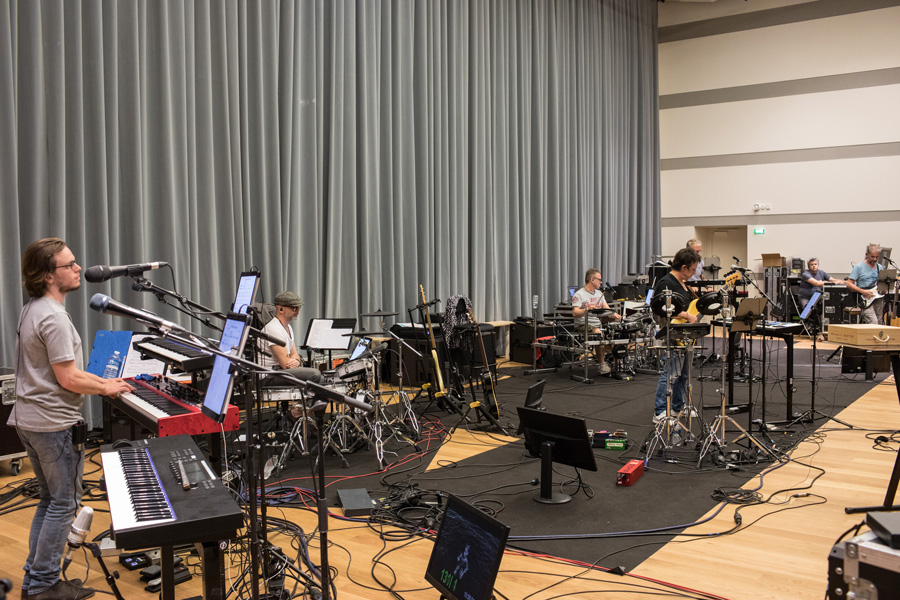
SLU : Seb, when did you step in this venture?
Seb Barbato : In January, when I heard this would be a L-Isa operation. As I had never mixed with it, I went for thorough training to Marcoussis (L-Acoustics’HQ, Ed.) to understand the philosophy of working in multi-channel and more simply in stereo. I came with stems from my concerts and spent an entire day playing in their listening room.
Maxime Menelec : As at today this studio has changed its Kara for Syva et Syva Low models.
Seb : This was very useful because you have to think of your mix differently to get the most out of the resources in front of you.
SLU : And why choosing DiGiCo and the SD7 ?
Seb Barbato : It was inevitable given the resources required, the use of the Optocore loop, the fact that Ben at monitors has the same and that we both have Waves servers preprogrammed by Romain. The latter did a crazy job since he recreated us with identical copies of the famous reverberations of the original Big Blue soundtrack without needing to bring out the old Midiverb from the dust. We would never have had the time to research and program all these algorithms for ourselves. He created 10 reverbs for us in 60 snapshots, all different, matching the music vibes. Even without good math, this is not far from 600 presets!
SLU : Apparently you too have made the choice to delegate the matrixing and spatialization parts to a third person …
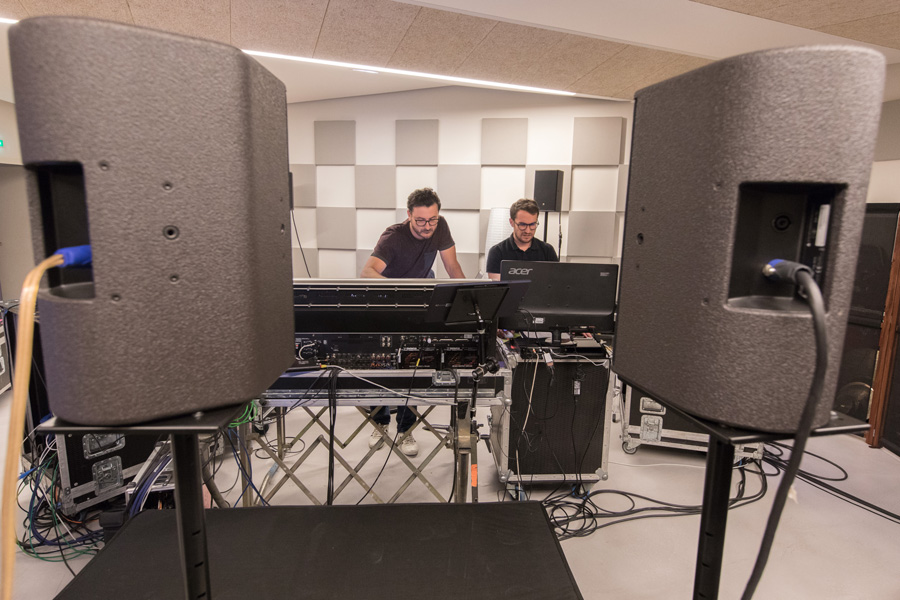
Seb Barbato : It’s easier and the DiGiCo & L-Acoustics plug arrived last week. Installing it involves removing the Waves reverberations from the console although they are perfectly encoded. We didn’t take the risk.
In addition we have a patch with 130 inputs in the desk and we reduce that to 96 to attack the processor which cannot not take more channels. We agreed on the fact that Max pre-places the sources and I add my own magic into the console. We know each other very well and we hear the same thing. As a single engineer working on a full SD7, you cannot take over the management of L-Isa.
SLU : Even if one day there’s a perfect merge of L-Isa in all the mixing consoles?
Maxime Menelec : The complexity of the configuration that we have set up makes it impossible to work alone. We are not going out thru the post-fader direct outputs, we had to go through the solution of the 96 aux busses, which means that for each title we must route the 130 tracks, or more, in it…
Seb Barbato : L-Isa forces you, in the good sense of the term, to seek how to exploit this space, this immersion at your disposal, and this is true for each track, while keeping the main sources in the same place.
SLU : But it is quite possible that you will have to rectify all or part of it when you listen with a screen, a K2 / Kara / Kiva II system much wider open and in a large hall…
Seb Barbato : Ahh it’s clear that everything will change. I left a lot of things off to go fast. We know what happens between a rehearsal place and a tour in stereo, we will find out here with an L-Isa deployment placed behind a screen, even microperforated!
Maxime Menelec : I even wonder if the KS28 placed a meter and a half from the screen will not make it get into vibration (laughs), (but fortunately it will not vibrate, Ed.)
Romain Berguin, the musical speleologist
We cannot repeat enough the importance of the work carried out by Romain Berguin, or let’s say we can, we will explain it to you in a few lines but first …
SLU : When did you start to work for Eric Serra ?
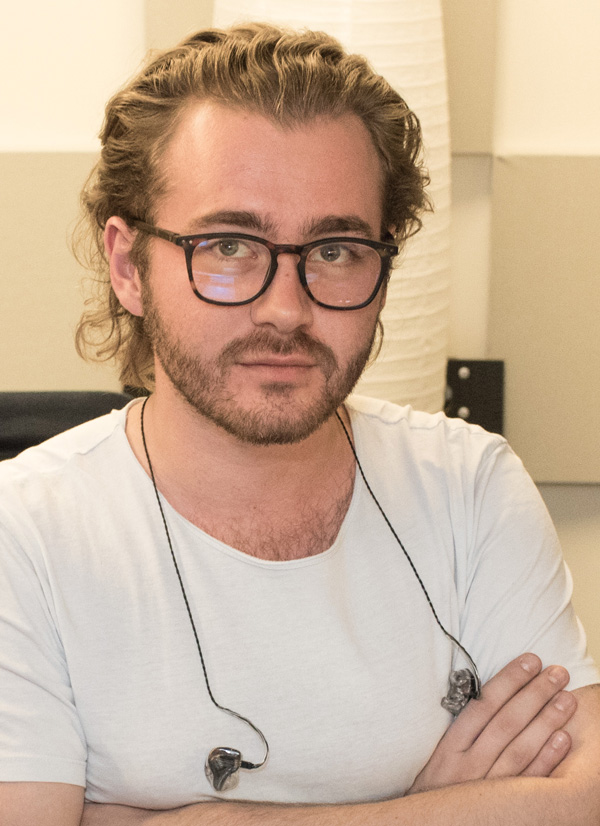
Romain Berguin : It was in 2015 during a project prepared for the Grand Rex big Paris cinema, a best of his film music played by his group with video extracts from the various movies. I was contacted by Eric to help him find, compile and somehow help organize this gig.
For two months we dug through its well-kept archives to release what was needed, movie by movie, and I worked in his studio to provide the musicians with what they needed. I also remixed all the titles from multitracks, managed Ableton, time code and, icing on the cake, I played on stage!
After that gig at the Rex, the tour did not take place for production reasons, but I officially became his assistant and I have had the pleasure of working with him on a new soundtrack for 18 months since then. It must be said that his studio is built as a huge configuration.
What we have tonight must represent 10% of what it has there in terms of digital complexity. There is very old and very modern gear at the same time, and you have to make everything work. There are as many items as in a pro studio, but it’s designed like a home studio with everything close at hand. You can do anything in every way, hence the complexity.
SLU : And before working with Eric ?
Romain Berguin : I started coming to Paris at quite a young age to play in clubs and start my personal network as a musician, rather playing jazz on bass and piano. I then gave up bass and moved to Paris.
SLU : What about you, Max ?
Romain Berguin : We met at Eric Tourneur’s (him again! Ed.) because we’re both from Périgueux. We’re pals since a long time and we came to the technique in the same way.
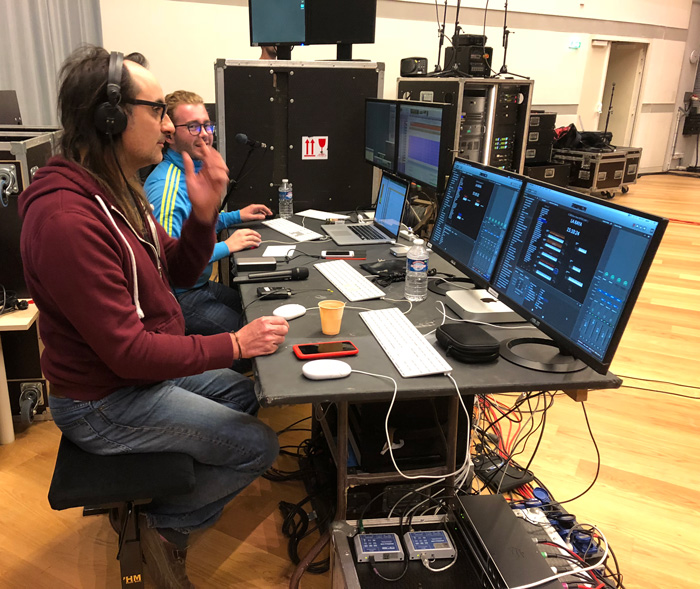
SLU : Let’s get back to The Big Blue. It’s you who searched, found the sources and is the master of ProTools and effects that are truly essential for this soundtrack (smile). It’s on your PT session that we find the separate tracks of the studio soundtrack. How many tracks there?
Romain Berguin : 32 digital tracks (Mitsubishi or 3M reel-to-reel, there were quite a few of these in Paris at the end of the 80’s, Ed.). The problem is that this tape was transferred 15 years ago to a ProTools 24, necessarily in two separate multitrack copies, and that unfortunately something changed during this digitalization process, which meant that we had to struggle to realign everything. It lacked some material! But we delivered everything right on time.
SLU : I kinda feel the confusion rising with the number of frames per second…
Romain Berguin : And you’re damn right. The audio was composed at 25 frames per second and the film shot at 25 fps, however during the first projection Eric was quite surprised because the projectors of this cinema rolled at 24 fps!

SLU : So the film lasted longer and the tone was lower pitched in cinemas …
Romain Berguin : Yes, but when the DVD was made in “frame based”, the image was changed to 25 fps, but the sound remained in the pitch of the 24 fps as it was heard in cinemas, and not in the original pitch. It sounds obvious said like that, but it took me a while to understand. (Take a stroll on YouTube and listen to the opening credits sequence as posted by various people, it’s pretty neat).
We therefore time-stretched the whole session to convert it in 24 fps because the decision was made to work in 24 fps format. The hardest part was then to generate a click track to be able to play it live in perfect sync with the movie. It should be remembered that this soundtrack was composed, to the nearest image, by Eric, but he had not planned that one day it could be played live on stage by musicians …
SLU : The number of meeting points between audio and image is impressive. How is the sound on the multitrack, worked or dry.
Romain Berguin : No, dry, nothing added, the first time it did sound weird because it doesn’t work. I think the original mix was done with 8 reverb channels.
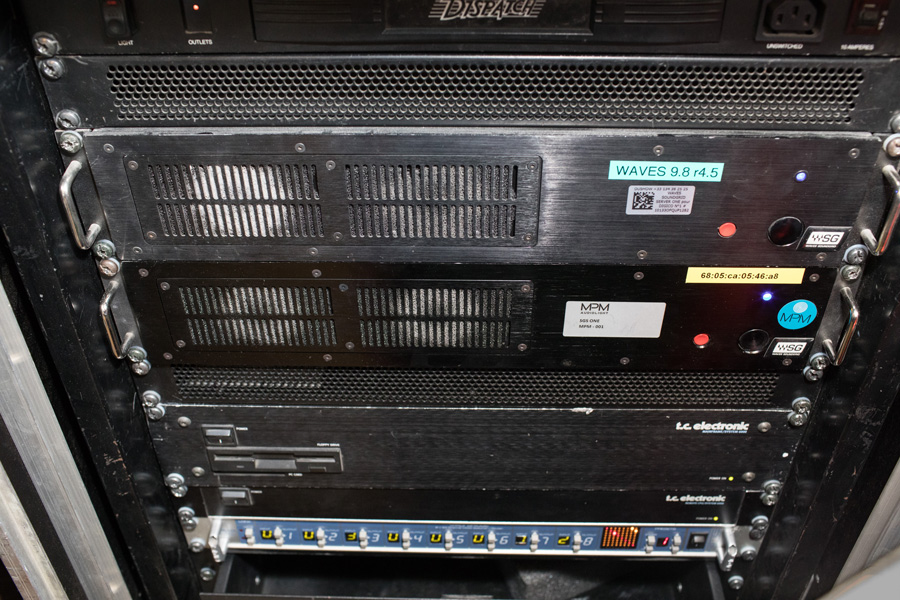
SLU : How did you manage to find the sounds and program your algorithms…
Romain Berguin : I listened to the original movie’s mix, and thought I was going to be able to work on a few presets, but I quickly became disillusioned. I then inserted the Multirack Waves into my ProTools set up in MADI and I made the automation of my sends as with a real console.
This subsequently allowed me to deliver two servers for FOH and monitors with instructions on which source to send to which algorithm and at which level.
SLU : What about the Midiverb of the time?
Romain Berguin : We didn’t use them (LOL).
A server not that helpful
During a number, an ugly click is heard, it is not the first time and it is ugly enough to trigger a deep search to flush it out. No luck for it, there are in the studio Ben, Seb, Max and Romain. So it has no chance indeed. After eliminating the clocks, the sources and the mixes one by one, the eyes are on the Waves server.
Bingo! The fault comes from there. When creating the effects and automating them, Romain programmed a change of pre-delay to one of the countless reverberations, but in the middle of the title. What used to be OK at home is now indigestible for a busy server. A few manipulations and it goes from click to death.
SLU : Did the import of the effects session into the consoles go well?
Ben Rico : It was not easy. Romain worked in the studio on his ProTools HD and a Mac dedicated to Multirack, and the SD7 has its own way of working, where the server is exactly the same.

So we had to change all the names of the snapshots so that they were strictly identical, we had to add the number of the snapshot in the session and vice versa, otherwise we ended up with the same reverb everywhere.
We also had labelling problems because in the console there are commas and in the MultiRack there are periods. So we called to the rescue Claude Rigollier from DV2 who himself took on Waves. We haven’t been smart for a week. (laughs!)

Seb Barbato : Claude also helped us a lot with the Optocore because again, we are at the limit.
Maxime Menelec : This Optocore loop allowed us to very simply send the signal between the two DiGiCo consoles (FOH and monitors) and the SD rack, but also via three DD4s, to give life to Romain’s ProTools, J-Phi’s MainStages and the L matrix -Isa.
When we add up the total number of channels in the loop, we exceed the 504 admissible. So we had to downgrade, reconfigure all the DD4s one by one, so that each one does what we need. By default they provide as many channels in both directions, which is useless for us.
Ben Rico : When we connected the loop we got an alert like “you connected 1500 channels! (Laughs!)
SLU : Romain, what exactly does your ProTools in the loop?
Romain Berguin : Lots of things (smiles). I record and play sound. You should know that performing on stage The Big Blue with 7 musicians is a feat because there are a large number of sounds to send and necessarily, right at the right time.
The two drummers Loïc and David, for example, play everything in addition to some drum sounds, and can sometimes send honks or cymbals with the kick (laughs). To help themselves, they record their own voice giving instructions, cues which will be sent in their ear-monitors by Ben.
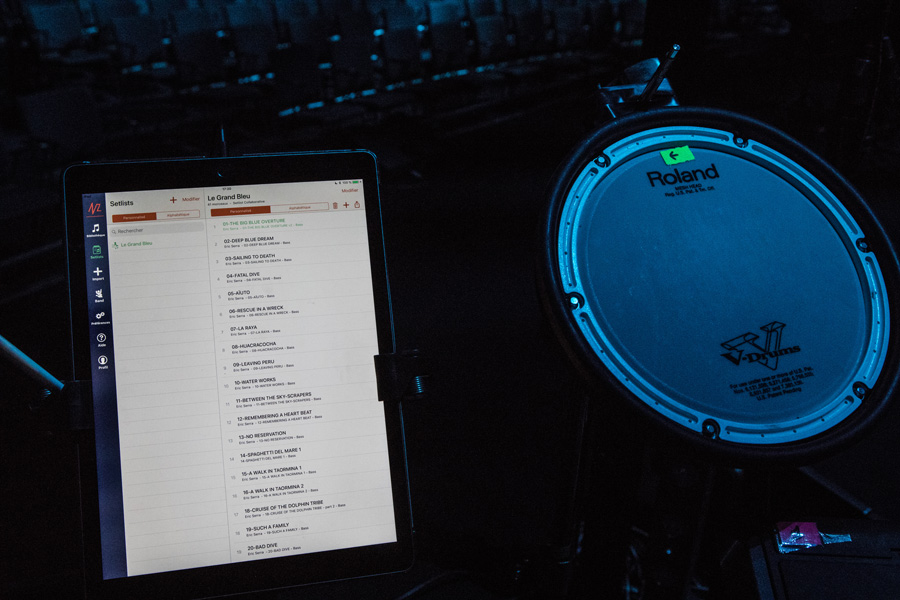
In addition to all that, I send the movie soundtrack (5.1 and dialogues), the cues for each musician, adapted to their own instrument, and some sound design tracks that it would have been useless to add to what the musicians (Eric also has a keyboard besides its bass, Ed.) have to perform.
We made in the studio the distribution between all the sounds to be played, with a certain logic, but without asking their opinion to the musicians who, once in front of their scores, were passed on to them (laughs). The scores take into account the latest distribution and are somewhat dynamic thanks to a web server.
SLU : Is your configuration redundant?
Romain Berguin : Of course, there are two Protools HD which run in parallel with two HD MADI and an automatic switch in the event of a crash.
SLU : What will be your role on the Big Night?
Romain Berguin : I will especially monitor the sync with the server media which delivers the image for the 4 video projectors, 2 main ones and 2 spare ones. The film file is 900 GB big. The server also delivers an image to each musician in which is embedded the measure count generated from the ProTools HD.
SLU : Thanks to this measures count, we find that Eric enjoyed a lot changing times on the fly.
Romain Berguin : Ahh sure you better follow up. We go from 5 to 4 and from 4 to 3 beats very easily.

The time has come to rise to the surface, a few days before diving back to the Seine Musicale hall for an interview with Jean-Philippe Schevingt, the sound designer, then to discover the Grande Seine hall, its huge screen, the L -Isa configuration and… enjoy this moment like no other when, as with an HR sound file, you rediscover an old song with a new emotion and goose bumps that believe they’re enjoying 14th of July!




